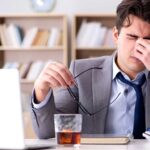Drug and Alcohol Use in the Workplace: Effects & Implementing Policies
22 March, 2024

Drug and alcohol use in the workplace leads to several adverse effects on the company and individual. This includes decreased productivity, increased safety risks, and legal liabilities for the employers. Substance abuse can also lead to various health issues for the employee. Hence, implementing policies to address it is crucial. The policy should cover the expected behaviours of employees, testing procedures, and disciplinary actions for violations. They may also include provisions for establishing education and assistance programs.
A clear and comprehensive workplace policy is vital for preventing the damaging effects of drug use from affecting the company. However, proper implementation is also necessary to demonstrate commitment to safety and health. Drug and alcohol testing is one measure that has beneficial effects in deterring substance abuse in current employees and identifying prospective employees unfit for safety-sensitive positions. This article will present information on the effects of substance use, implementing policies for it, and treatment programs.
Effects of Drug and Alcohol Use in the Workplace
Illicit drug and alcohol use can have several adverse effects on the workplace. This is why it is crucial for companies, particularly those in high-risk industries, to identify substance misuse. Firstly, impaired employees in safety-critical positions increase workplace accident rates. This can lead to injuries and fatalities within the worksite or on the roads. It can also increase operation costs, healthcare costs, and insurance premiums.
Secondly, drug and alcohol use in the workplace can also affect productivity and morale. Impaired employees tend to have impaired judgment and lower outputs. This can lead to errors, missed deadlines, and conflicts with other employees. Moreover, it can affect employee morale since people under the influence of alcohol or drugs tend to be more sensitive. They create a hostile work environment, which can increase employee turnover.
Thirdly, the irresponsible use of liquor and drugs by employees can lead to reputational damage. High accident rates can discourage applicants and clients from working with the company. Moreover, it leaves the company vulnerable to legal risks for being unable to fulfil its obligation to protect workplace health and safety.
Impact of Illicit Substance Use to Employees
- Illegal drug and alcohol misuse can cause employees to have lower mental and physical abilities due to impairment.
- With long-term use, they may develop health issues, such as brain, kidney, lung, and liver diseases.
- Drug or alcohol-related problems can cause frequent absences and tardiness, which can lead to dismissal for breaches of the policy and subsequent financial issues.
- It may also cause the worker to have strained personal and workplace relationships since they are more likely to be irritable or violent.
- Illicit drug and liquor use also increases their risks of being charged with drug driving and other criminal offences.

Implementing Policies for Drug and Alcohol Use in the Workplace
Implementing a workplace policy is crucial for monitoring drug and alcohol use in the workplace. A policy is a legal document that provides guidelines for substance use within the company premises or during work hours. It may also cover expected behaviours from employees during company-sponsored events or while acting as a representative.
To ensure compliance with the workplace drug and alcohol policy, companies may also establish an alcohol and drug testing program. It should state the types of tests and procedures for testing. It must also clearly inform the employer of the reasons for testing and the consequences of failing or refusing drug or alcohol testing.
To form this policy, the company may establish a development group composed of employee representatives, safety representatives, and management representatives. Alternatively, smaller companies may opt to have a consultation with employees. This helps ensure that the alcohol and drug testing policy can effectively address the drug and alcohol issues in the workplace. Conducting a risk assessment to identify hazards related to alcohol and drug issues may also prove helpful.
Importance of Having a Clear Policy in Place
Having a clear company policy on substance misuse is vital for several reasons. Firstly, providing clear guidelines on acceptable behaviour provides a set distinction between safe and dangerous conduct. This promotes accountability and responsible decision-making in relation to alcohol and drug misuse.
Secondly, a clear policy can help mitigate risks and prevent misunderstandings regarding rules on drug and alcohol consumption in the workplace. It can also help establish safeguards to address issues when they arise. Lastly, the policy can protect the company from litigation due to unsafe practices or negligence by enforcing active measures against safety issues.

Treatment Programs for Drug and Alcohol Use in the Workplace
Including treatment programs for drug and alcohol use in the workplace is an effective measure for ensuring the well-being and safety of employees. These programs provide employees with substance use disorders with resources to address their health issues. These are crucial for overcoming addiction and reducing the negative impact of substance abuse on their personal and professional lives.
Employment Assistance Programs (EAPs) may include external counselling services from a health professional and access to support groups. They may also provide resources for treatments to demonstrate their commitment to the well-being of their workers. This can effectively reduce the impact of drugs on the workplace. It also encourages safe consumption of alcohol and drugs.
Furthermore, to help mitigate these issues, companies can also establish education programs and provide training to employees to raise awareness of the dangers of drug and alcohol abuse, including the effects of alcohol and drugs on health and safety. It can help with drug prevention and decrease the rates of substance use among employees.
Resources for Recovery
In Australian workplaces, there are several resources available for individuals seeking help with substance use disorder recovery. Foremost, the company can provide EAPs to help their employees. Access to counselling services is one resource that can help with mitigating and intervening with substance misuse. It is also crucial for recovering from alcohol and drug dependency.
Access to support groups can also help individuals recovering from substance misuse. They can aid by providing a network of individuals going through similar experiences and offering guidance and support. Additionally, companies can provide access to treatment programs such as rehabilitation centres or outpatient programs to assist employees.
Conclusion
Drug and alcohol use in the workplace is an issue that can cause low productivity and higher rates of accidents. It can also cause reputational damage, discouraging top applicants and clients from engaging with the company. It also leaves the company vulnerable to legal risks since they may become unable to fulfil their obligations to protect the safety of employees. Therefore, having a clear policy in place to address substance misuse is vital.
A policy outlines the expected behaviours and processes related to enforcing the policy. A common inclusion is drug testing procedures to identify employees violating the agreed-upon policy. Companies may also establish treatment programs to provide resources for employee recovery and rehabilitation. Together with education programs, access to treatments can protect the well-being of workers while safeguarding the reputation of the company. It can also lead to higher morale and increased productivity.






























